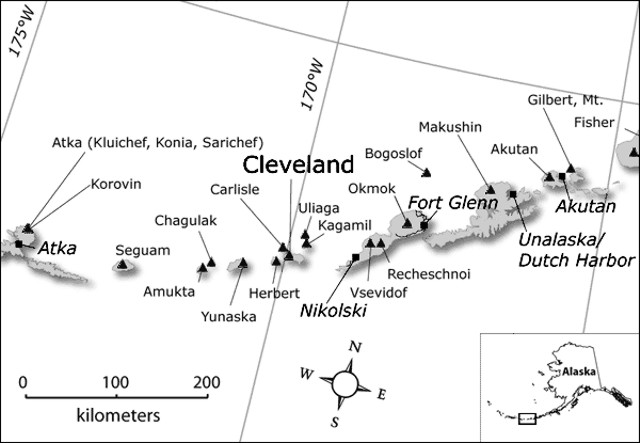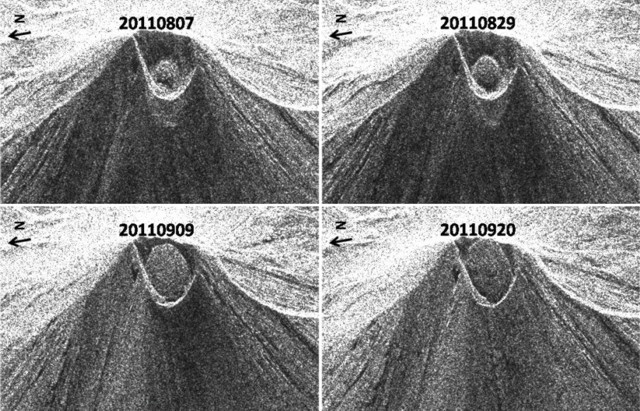Report on Cleveland (United States) — August 2011
Bulletin of the Global Volcanism Network, vol. 36, no. 8 (August 2011)
Managing Editor: Richard Wunderman.
Cleveland (United States) Dome growth during August-September 2011 seen evolving in radar data
Please cite this report as:
Global Volcanism Program, 2011. Report on Cleveland (United States) (Wunderman, R., ed.). Bulletin of the Global Volcanism Network, 36:8. Smithsonian Institution. https://doi.org/10.5479/si.GVP.BGVN201108-311240
Cleveland
United States
52.825°N, 169.944°W; summit elev. 1730 m
All times are local (unless otherwise noted)
Figure 10 shows the location of Cleveland volcano, the scene of significant changes in dome morphology in August and September 2011. On 31 March 2011 the Alaska Volcano Observatory (AVO) lowered the Volcano Alert Level and the Aviation Color Code for Cleveland to Unassigned, noting that no eruptive activity had been confirmed during the previous few months (BGVN 36:05). Cleveland lacks a real-time seismic network, which means AVO cannot track local earthquakes and estimate volcanic unrest. AVO notes that short-lived explosions with ash clouds that could exceed 6.1 km altitude can occur without warning and may go undetected on satellite imagery for hours. Low-level ash emissions at Cleveland occur frequently and do not necessarily mean a larger eruption is imminent. AVO continues to monitor the volcano using satellite imagery.
AVO reported that on 20 July 2011 the Volcano Alert Level for Cleveland was raised to Advisory, and the Aviation Color Code was raised to Yellow due to thermal anomalies visible in satellite imagery during 19-20 and 22 July 2011. Cloud cover prevented observations during 21 and 23-26 July.
During the week of 25-31 July 2011 elevated but weak thermal anomalies were observed in satellite images of during periods of clear weather. AVO found no evidence of ash emissions or eruptive activity. Observations on 29 July 2011 showed a small lava dome ~ 40 m in diameter in the summit crater, apparently formed since 19 July based on measured thermal anomalies. Observations on 2 August revealed growth of the lava dome from ~40 to 50 m in diameter. In response, AVO raised the Aviation Color Code to Orange and the Alert Level to Watch.
An animated sequence of satellite radar images revealed what was hard to see through persistent weather clouds. They portrayed dynamic growth of the lava dome during early August through at least late September 2011 (figure 11).
AVO reported weak thermal anomalies in satellite imagery during 2-3, 5, 7-9, and 13-14 August when cloud cover was limited or absent. They noted that a scientist flying N of the volcano on 14 August observed small white puffs of steam rising 30-60 m above the summit, even though most of the volcano was obscured by clouds.
During 17-23 August cloud cover over Cleveland prevented observations of the summit crater. On 21 August AVO noted that a weak, 1-pixel thermal anomaly was observed in a recent satellite view during a cloud break. On 30 August 2011, satellite observations during the previous two weeks indicated a pause in lava-dome growth. AVO lowered the Volcano Alert Level to Advisory and the Aviation Color Code to Yellow. Cloud cover prevented views of the summit crater during 31 August-2 September, but a thermal anomaly at the summit was observed during 3-5 September.
Observations on 6-7 September 2011 indicated that the lava dome had resumed growth (figure 11), reaching 120 m in diameter and filling the floor of the crater. AVO again raised the Volcano Alert Level to Watch and the Aviation Color Code to Orange. Although cloud cover often prevented observations of Cleveland during 7-12 September, a thermal anomaly on the lava dome was visible during 8-9 and 12 September, and a possible anomaly was visible on 10 September. These anomalies suggested that lava-dome growth was continuing, although no activity was observed in partly cloudy satellite images during 12-17 September. During 17-18 September a thermal anomaly was detected in imagery.
A report on 20 September noted that recent observations revealed the lava dome had grown to ~165 m in diameter. The dome remained contained within the ~ 200-m-diameter crater at Cleveland's summit, having advanced to ~ 20 m below the E crater rim.
During 20-22 September no observations of elevated surface temperatures or ash emissions from Cleveland were visible in partly cloudy satellite images. Elevated surface temperatures were observed in satellite images during 23-24 September, suggesting that the lava dome eruption was continuing. On 24-25 September 2011 elevated surface temperatures were absent in several clear satellite images. Cloud cover prevented observations on 26 September. Satellite views detected continued elevated summit temperatures over the period 27-28 September 2011. Satellite data also suggested ongoing eruption as the lava dome continued growing.
Geological Summary. The beautifully symmetrical Mount Cleveland stratovolcano is situated at the western end of the uninhabited Chuginadak Island. It lies SE across Carlisle Pass strait from Carlisle volcano and NE across Chuginadak Pass strait from Herbert volcano. Joined to the rest of Chuginadak Island by a low isthmus, Cleveland is the highest of the Islands of the Four Mountains group and is one of the most active of the Aleutian Islands. The native name, Chuginadak, refers to the Aleut goddess of fire, who was thought to reside on the volcano. Numerous large lava flows descend the steep-sided flanks. It is possible that some 18th-to-19th century eruptions attributed to Carlisle should be ascribed to Cleveland (Miller et al., 1998). In 1944 it produced the only known fatality from an Aleutian eruption. Recent eruptions have been characterized by short-lived explosive ash emissions, at times accompanied by lava fountaining and lava flows down the flanks.
Information Contacts: Alaska Volcano Observatory (AVO), a cooperative program of a) U.S. Geological Survey (USGS), 4200 University Drive, Anchorage, AK 99508-4667 USA (URL: http://www.avo.alaska.edu/), b) Geophysical Institute, University of Alaska, PO Box 757320, Fairbanks, AK 99775-7320, USA, and c) Alaska Division of Geological & Geophysical Surveys (ADGGS), 794 University Ave., Suite 200, Fairbanks, AK 99709, USA (URL: http://www.dggs.alaska.gov/).



